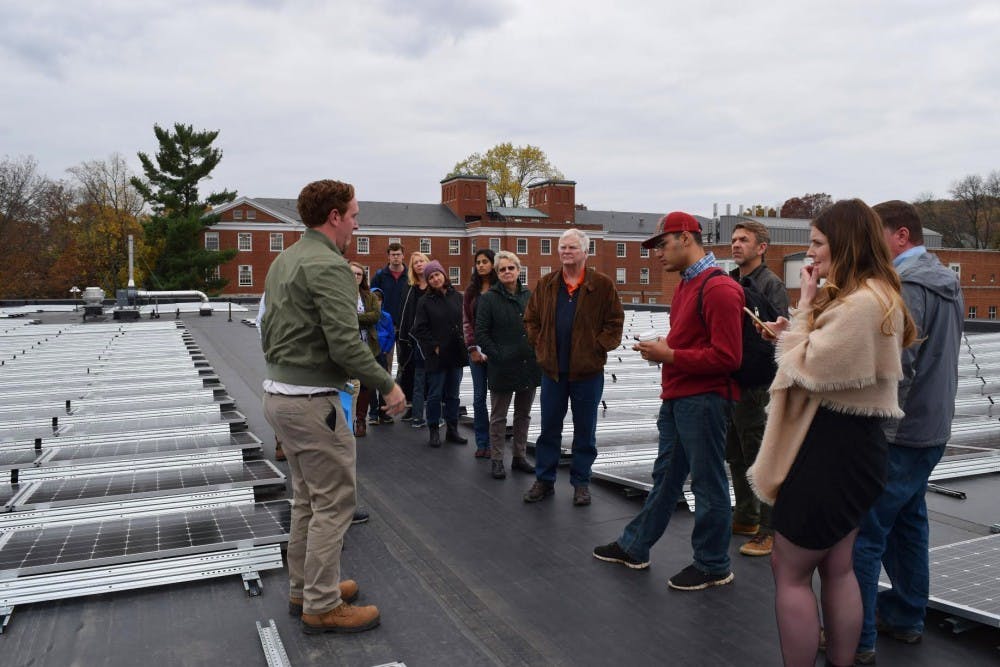As a new school year begins and University President Jim Ryan takes his position at the helm, the University finds itself at an especially important intersection. The University has everything it needs to take a leadership role in tackling the greatest global threat of our time — climate change. From the operational know-how, to the enthusiasm and talent of students, to the deep bench of research and expertise among faculty, the University has incredible potential in advancing sustainability. Now is the perfect time to set a bold, yet achievable vision to achieve carbon neutrality by 2035.
It’s also a critical time. As with any intersection, there is a divergence in the road. If the University misses this moment, it risks falling behind many other universities and failing its stakeholders.
Fortunately, we have a visionary new leader who believes that universities should be a force for good in the world. We agree. And we urge the University to act now.
There are four powerful reasons why the University should seize the current opportunity to set a carbon neutrality goal — a goal of net-zero carbon emissions from operations and transportation — by 2035.
First, it will position the University as a sustainability leader. A goal of carbon neutrality by 2035 will demonstrate the University’s global leadership and propel innovation, while attracting and retaining students, professors and research dollars. Increasingly, students and faculty are incorporating sustainability issues into their decisions about universities, while over 600 higher education institutions have set a carbon neutrality goal.
In addition, the University has world class research and teaching assets on climate change across multiple schools and departments. Sustainability is clearly top of mind for students and faculty, as evidenced by the new Environmental Resilience Institute, as well as sustainability’s surge as a large special-interest group among students and new alums. However, leading in study and enthusiasm is not enough. We must also lead in practice.
Secondly, reducing net greenhouse gas emissions to zero will have tremendous environmental impact. Addressing energy use and emissions is a big part of the University’s commitment to strengthening our community, promoting discovery and deepening service to make a positive impact on the world.
The University’s carbon footprint, even when the current 25 percent GHG reduction goal is met, is still considerable — over 250,000 metric tons of carbon dioxide equivalent, or nearly twice the annual electricity used by all the homes in Charlottesville, combined. Shaving off emissions in incremental percentages cannot continue to outpace the growth of the University in square footage and population, nor the effects of a warming planet.
Furthermore, these percentage goals keep the University trapped in a scarcity mindset — focused only on how to do more with less. Embracing carbon neutrality opens up the opportunity to reframe the problem, innovate with leapfrog technologies and find creative solutions.
Achieving carbon neutrality is also a strategic and responsible way to manage risk and cost. Decarbonizing the University's operational emissions mitigates financial and reputational risk associated with inevitable regulation and mounting stakeholder concerns among both college applicants and leaders in capital markets.
It is also a smart, high return-on-investment that improves resource efficiency and lowers energy and water costs. Energy efficiency investments have a proven 20 percent or more in annual returns, minimal volatility and zero exposure to market and geopolitical risk, while costs of solar and wind energy continues to decline as production volumes increase.
Finally, carbon neutrality is achievable. We know this from the efforts of many comparable institutions, such as Arizona State University’s comprehensive plan and carbon neutrality goal of 2035, demonstrating that going neutral is actually the least expensive path forward. Harvard University also recently announced a plan to end its use of fossil fuels by 2050 with an interim goal to become carbon neutral by 2026.
We also know it’s achievable due to the falling costs of renewables, surging technological advances in energy storage and Charlottesville’s aspirations to become the renewable energy hub of the Southeast. Most importantly, we know it’s achievable based on the University’s own capabilities and achievements — most notably its 19 percent reduction in emissions from a 2009 baseline.
Taken together, all signs at this intersection point to moving aggressively and purposefully towards carbon neutrality. But to do so will require the steer of leadership and bold vision.
In order to achieve carbon neutrality by 2035, the University must shift its perspective from near-term budget pressures to long-term strategic optimization, incorporating carbon and energy impacts into all of its energy and transportation decisions. A reframing of the problem, combined with higher prioritization and more resources, will unlock new solutions, propel innovations and open up new paths to success.
Sure, it’s a large shift. But it’s one entirely within the University’s reach.
Grey McLean is a graduate of the College, Class of ‘95 and is the founder of Wahoos for Sustainability.
Elizabeth Beauvais is a graduate of the College, Class of ‘98 and is a member of Wahoos for Sustainability.





